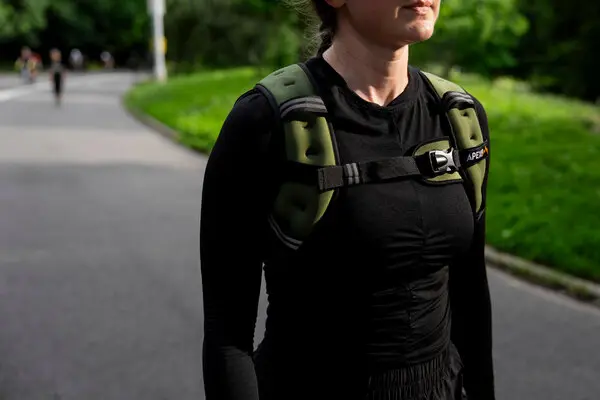The Benefits of Walking with a Weighted Vest for Enhanced Fitness Results

Walking is one of the most accessible forms of exercise. It requires no special equipment, can be done almost anywhere, and provides a wide range of health benefits. But for those looking to increase the challenge and boost results, adding a weighted vest can transform an ordinary walk into an effective full-body workout. From improving cardiovascular health to building strength and bone density, walking with a weighted vest can make a real difference in your overall fitness level.
In this article, we’ll explore the benefits of weighted vests, the advantages of walking-specific weighted vests, how to choose the best walking weighted vests, and why even seniors can safely enjoy weighted walking with the right gear and approach.
What Is a Weighted Vest and How Does It Work?
A weighted vest is a specially designed piece of fitness equipment worn on the torso, evenly distributing additional weight across the body. It can range from light models (2–10 pounds) to heavy-duty versions (30 pounds or more). The idea is simple: adding weight increases the effort required during movement, which in turn raises calorie burn and muscular engagement.
When you walk wearing a walking-specific weighted vest, your body works harder to maintain balance, posture, and endurance. This added resistance increases your heart rate, strengthens your core, and improves bone and joint health over time. The result is a more efficient, calorie-burning, and muscle-toning workout — all while performing a low-impact exercise suitable for nearly everyone.
1. The Benefits of Weighted Vests for Walking
The benefits of walking with a weighted vest extend far beyond just burning a few extra calories. Let’s look at the main advantages:
1.1 Increased Calorie Burn
When you add extra weight to your body, your muscles need to work harder to move you forward. Even a 10-pound weighted vest can increase energy expenditure by up to 10–15%. This makes your walking sessions more productive without needing to extend their duration.
1.2 Improved Cardiovascular Fitness
Adding resistance naturally elevates your heart rate. Over time, this helps to strengthen your heart and improve endurance. Many fitness experts recommend using walking-specific weighted vests to enhance the aerobic benefit of walking without switching to high-impact exercises like running.
1.3 Enhanced Muscle Engagement
A weighted vest activates more muscle groups, particularly the core, back, glutes, and legs. The extra weight challenges your stabilizer muscles, helping you maintain posture and balance. This is especially beneficial for individuals seeking functional strength rather than just muscle size.
1.4 Bone Density and Joint Health
Research shows that adding resistance to low-impact exercises like walking stimulates bone formation. For older adults, weighted vests for seniors can be a safe way to help prevent osteoporosis by strengthening bones and improving coordination.
1.5 Better Posture and Core Stability
Carrying extra weight on your torso naturally encourages proper posture. To keep the spine aligned, your core muscles engage continuously throughout your walk. Over time, this can lead to improved balance and reduced risk of back pain.
2. Weighted Walking for Seniors: A Safe, Effective Option
Contrary to what some may believe, weighted vests for seniors can be extremely beneficial when used properly. Older adults often experience reduced bone density and muscle mass — conditions that weighted walking can help counteract.
2.1 Low Impact, High Reward
Unlike jogging or high-intensity workouts, walking with a weighted vest remains gentle on the joints. Seniors can safely enjoy resistance training benefits without putting stress on knees, hips, or ankles.
2.2 Enhanced Mobility and Balance
The mild resistance from a senior-specific weighted vest strengthens stabilizing muscles and improves balance, reducing the risk of falls — a major concern among older adults.
2.3 Caution and Gradual Progress
It’s important for seniors to start light. A weighted vest under 5 pounds is usually a good starting point. As strength and comfort increase, the weight can be adjusted. Consulting with a healthcare provider or physical therapist before starting is recommended.
3. The Benefits of Walking with a Weighted Vest: Scientific Insights
Many studies have confirmed the benefits of walking with a weighted vest. For example, research published in The Journal of Strength and Conditioning Research found that participants who walked with weighted vests improved cardiovascular endurance, leg strength, and caloric output compared to those walking without resistance.
Another study on bone health revealed that postmenopausal women using weighted vests for walking showed higher bone density scores than those who performed bodyweight exercises alone.
These findings highlight that weighted walking isn’t just a trend — it’s an evidence-backed method for improving physical fitness safely and effectively.
4. Choosing the Best Walking-Specific Weighted Vest
Not all weighted vests are created equal. The best model depends on your fitness goals, comfort preferences, and safety needs. Here’s what to consider when selecting the best walking weighted vest for you:
4.1 Fit and Comfort
A walking-specific weighted vest should fit snugly without restricting movement. Adjustable straps and ergonomic designs ensure even weight distribution, minimizing shoulder and back strain.
4.2 Weight Adjustability
Look for a vest that allows you to modify the weight incrementally. Beginners may start with 5–8% of their body weight, while more advanced users can go up to 15%. Adjustable weights make it easy to progress safely.
4.3 Material and Breathability
Since walking often takes place outdoors or for extended durations, breathable fabric and durable stitching are essential. Many of the best walking-specific weighted vests use moisture-wicking materials for comfort during longer sessions.
4.4 Design for Purpose
While some vests are made for running or cross-training, walking-specific weighted vests are usually shorter and allow more natural arm movement. They sit higher on the torso to reduce hip contact and improve stride comfort.
4.5 Safety Features
If you plan to walk outdoors, consider models with reflective strips or bright colors for visibility. For seniors or evening walkers, these safety elements are especially important.
5. How to Start Walking with a Weighted Vest Safely
Even though weighted walking is generally safe, it’s important to start gradually to avoid overuse injuries or muscle strain. Here’s a recommended approach:
Step 1: Start Light
Begin with a weighted vest that adds no more than 5–10% of your body weight. You can always increase the load as your endurance improves.
Step 2: Maintain Good Posture
Keep your shoulders back and your core engaged. Avoid leaning forward or changing your gait pattern, as this can lead to discomfort or injury.
Step 3: Keep Walks Short Initially
Start with 15–20 minutes per session. Once you’re comfortable, extend to 30–45 minutes while monitoring how your body responds.
Step 4: Combine with Other Exercises
Add short intervals of squats, lunges, or stair climbing during your walk to boost strength benefits. The weighted vest will make these movements more effective.
Step 5: Rest and Recovery
Give your muscles time to adapt. Use rest days between weighted walks, especially in the beginning.
6. Weighted Walking vs. Regular Walking: The Key Differences
While both forms of walking share similar health benefits, the intensity and results differ significantly.
| Feature | Regular Walking | Walking with Weighted Vest |
| Calorie Burn | Moderate | Significantly higher |
| Muscle Engagement | Low to moderate | High (core, glutes, legs) |
| Bone Health | Maintains bone density | Improves bone density |
| Cardiovascular Challenge | Mild | Enhanced |
| Posture Benefits | Minimal | Noticeable improvement |
| Ideal For | Beginners | Intermediate to advanced users |
Simple put,walking with a weighted vest amplifies the benefits of walking without making it high-impact. This makes it ideal for fitness enthusiasts aiming to get more results in less time.
7. The Bottom Line: Making the Most of Your Weighted Walks
Adding a weighted vest to your daily walks is one of the easiest ways to elevate your fitness routine. It turns an ordinary activity into a powerful strength and endurance workout — without requiring a gym membership or expensive equipment.
From building stronger bones and improving heart health to enhancing posture and calorie burn, the benefits of walking-specific weighted vests are well-supported by science and practical experience alike. Whether you’re a fitness beginner, a senior seeking safe strength-building, or an athlete looking to diversify your routine, weighted walking is a smart, effective, and sustainable choice.
When choosing your gear, prioritize comfort, safety, and gradual progression. Start light, walk consistently, and enjoy the lasting rewards of a fitter, stronger, and more balanced body.




